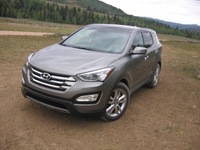2013 Hyundai Santa Fe Reviews By Steve Purdy
2013 HYUNDAI SANTA FE REVIEW
By Steve Purdy
TheAutoChannel.com
Michigan Bureau
Well, I have to say Hyundai has done it again. They’ve completed a major redesign of one of their cars that is so good we can find little to criticize no matter how hard we try. We just spent a day with the new Santa Fe driving the scenic mountain roads around Park City, Utah and have come away impressed with the revised car just as we were with Sonata, Elantra and Azera.
 |
This is the third generation of the Santa Fe, a crossover that has always been known for its value if not for style and design. Now we add style and design to its credentials and find the value nearly as impressive. The new Santa Fe adds one degree of evolution to Hyundai’s “Fluidic Sculpture” design philosophy. They’re calling this one “Fluidic Precision.”
 |
 |
You must look closely to differentiate the Sport from the longer Santa Fe. Subtle differences in the front fascia and more obvious differences in the side view may give it away, but both are very attractive in my subjective view.
 |
 |
 |
The Santa Fe Sport, at dealers now, is nearly identical to the outgoing model in most dimensions but ads considerable content, though subtracting 266 pounds primarily through the use of high strength steel in the substructure. Hyundai has its own in-house steel R& D and their own steel plants. Lots of other innovative little tidbits each add a bit to the weight loss.
Powering the Santa Fe Sport is one of two 4-cylinder engines: a 2.4-liter, normally aspirated, direct-injected engine making 190 horsepower and 181 pound-feet of torque, or you can get the much quicker 2.0-liter, direct injected, intercooled, twin-scroll turbo (integrated into the exhaust system) making 264 horsepower and a substantial 269 pound-feet of torque. Both use regular gas. The former rated by the EPA at 22-mpg in the city, 33 on the highway and 26 combined - the latter at 20/27/22.
The long-wheelbase Santa Fe, expected at dealers later this year or early next, also adds considerable content and looses almost 400 pounds from its Veracruz precursor. It comes in 6-passenger with captain’s chairs for 2nd row or 7-passenger with 40/20/40 split second row seat.
Only one engine-transmission combination can be had in this larger Santa Fe, the same 3.3-liter Lambda II V6 used in the new Azera generating 294 horsepower and 252 pound-feet of torque, rated by the EPA at 19-mpg in the city, 26 on the highway and 22 combined. This engine is mated to same slick new 6-speed automatic transmission used in the Sport, and most other Hyundai products. This efficient transmission was designed in-house and features a manual shift mode and an ECO System to smooth out throttle variations. It also never needs a filter of fluid replacement for the life of the car.
Suspension design is fully independent with conventional McPherson struts up front and an innovative multi-link system in the rear that is tucked into the wheel well so as not to intrude on cargo space. All-wheel drive is offered in both models, with an electronically controlled coupling and torque vectoring system by Dyanmax.
Three steering modes are driver selectable – normal, sport and comfort – that simply add or subtract steering effort. With electric power steering it is a simple thing to do and offers drivers a little more choice.
With the revised Santa Fe they’ve added a driver’s knee airbag for a total of seven. All the other safety features continue and essentially match just about every new vehicle on the road including pre-tensioning seat belts, ABS, traction control, stability control, etc.
What did we think about the feel of the car and the driving dynamics?
Glad you asked.
 |
Our Santa Fe Sports never had to gasp for breath though we need to downshift ourselves on some of the long slopes. We could have goosed the throttle and forced the transmission to downshift but it seemed more convenient to just use the manual mode. We switched frequently between the steering modes to see if we could really tell much difference and we certainly could. I liked the comfort setting. My young exuberant driving partner liked the sport mode.
Outstanding as well is the new Santa Fe’s “NVH” qualities. That’s the acronym used by engineers in reference to “noise, vibration and harshness.” Most of the comments I heard from other journalists on the trip were of amazement that the NVH was so good. I concur entirely. It is the equal of the much pricier Acura RDX we tested just a couple weeks ago.
Overall, I would have to give the new Santa Fe Sport a good, solid ‘A.’ It is dramatically designed without being garish, wonderfully balanced in ride and handling, plenty powerful and, as we’ve come to expect from Hyundai, a good value in terms of content for price.
Compare the Santa Fe Sport to Honda’s RAV4, the Chevy Equinox, Ford Edge and Kia Sorento. Compare the Santa Fe long wheelbase to the Honda Pilot, Toyota Highlander, Mazda CX9, Ford Explorer and soon to Nissan’s freshly redesigned Pathfinder which has now gone to unibody and front-wheel drive.
Santa Fe Sport starts at $24,450 for the base car and $27,700 for the turbo. Loaded up with most of the option packages you’re looking at around $35,000. Don’t expect generous rebates or other incentives since all of Hyundai’s new products are flying off the shelves as fast as they can get them to dealers. Pricing on the Santa Fe long wheelbase will be announced closer to its launch later this year.
Look for a full review of the 6/7-passenger Santa Fe later this year.
ęSteve Purdy, Shunpiker Productions, All Rights Reserved



